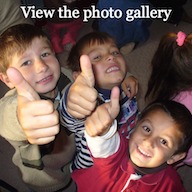Our last blog entry left you with the news of massive flooding and numerous landslides in Nepal. I have since learned that half the annual rainfall for Nepal fell on that one weekend at the end of September. We shared that our work trip to Tansen had been cancelled because of the poor condition of the roads and our inability to find flights at the late hour. Similarly, our planned work trip to the other UMN hospital, in Okhaldhunga, was also called off. Our original plan was to take these two trips as a family because it’s during the boys’ 2 1/2 week break for Dashain, the biggest holiday in Nepal.
In work news, I am kept busy with applications and inquiries related to the recruiting part of my position. I continue to have conversations (mostly via email) with people interested in coming to work for UMN. Sometimes people have specific ideas of what they want or need for the position to be appealing to them. When it doesn’t match the reality of the situation, it’s best to stop the process before more frustration or disappointment results. I am sad when that happens. Thankfully, other people are still in the hopeful conversation stage, which gives me energy and makes me eager to open my email in the morning and see the latest developments– whether it is another person we need to bring into the conversation, or a small hurdle we need to overcome. And thankfully there are several medical professionals in the pipeline requiring only occasional communication, whose situations and plans are progressing well and are mostly on autopilot.
Lora’s work was more affected than mine by the work trip cancellations. She had been planning on having individual and couple pastoral care visits and worship sessions with the expats at the two hospitals. However, she turned some of the worship plans into an email and sent it to those same expats, and was pleased when she learned that one of the doctors reported that they used it for a meaningful session at her hospital.
We also took part in a half-day HR team meeting where we analyzed our role in the larger organization of UMN and thought about what changes we could make to improve. The meeting was mostly in English, and our colleagues, who are all fluent in English, spoke to us in English. Yet there were many times they broke into Nepali when they were mostly addressing each other. In the video below, our colleague tells the rest of the group what we had discussed as we drew on chart paper, using the metaphor of a tree to describe UMN. Meetings like these are good practice for our Nepali.
I have been very intrigued to witness the changes in the city over the days and weeks of Dashain. One thing we saw many places around the city were tents set up for Durga Puja, or worship of the goddess Durga. Inside would be a number of statues or almost mannequin-like life-size figures that go along with the story of Durga battling and eventually being victorious over the forces of evil. People would come and go to these tents to offer a prayer, some money, linger a bit, or not. There was usually music and incense. The tent in the video below was on our way to work.


